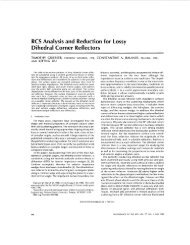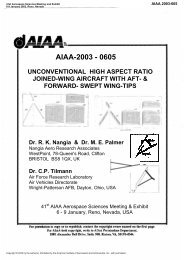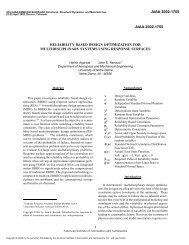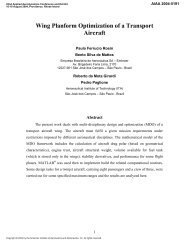Application of MDO to Large Subsonic Transport Aircraft
Application of MDO to Large Subsonic Transport Aircraft
Application of MDO to Large Subsonic Transport Aircraft
You also want an ePaper? Increase the reach of your titles
YUMPU automatically turns print PDFs into web optimized ePapers that Google loves.
(c)2000 American Institute <strong>of</strong> Aeronautics & Astronautics or published with permission <strong>of</strong> author(s) and/or author(s)’ sponsoring organization.<br />
Aerodynamic design<br />
Fliaht oerformance CalCulatiOn<br />
. Intluence.<strong>of</strong> flexlbiltty during<br />
. Rudder eflectiveness<br />
! I . Stability problem (tluI7erl ;<br />
I I<br />
Fig. 3 FAME-W design process<br />
Applka%on io a <strong>Large</strong> <strong>Transport</strong><br />
Problem description<br />
Structure dimensioning ----+ Weights<br />
Jig shape calculabor<br />
I]<br />
+,<br />
(Wing]<br />
‘+,<br />
1:<br />
_ _I Mcdly sthess _;<br />
/ and/or mass I<br />
To demonstrate the use <strong>of</strong> this <strong>to</strong>ol we posed the<br />
following test-problem.<br />
What preliminary design <strong>of</strong> the wing produces<br />
the minimum weight <strong>of</strong> the wing’ + fuel <strong>to</strong><br />
perform the harmonic mission (maximum<br />
payload) <strong>of</strong> a 5.50 pax very large transport? The<br />
maximum payload (in fuselage) mission is the<br />
most critical for the wing structure. We also<br />
wanted <strong>to</strong> know the sensitivity <strong>of</strong> this design <strong>to</strong><br />
errors made in the prediction <strong>of</strong> wing weight and<br />
drag.<br />
5<br />
American Institute for Aeronautics and Astronautics<br />
:<br />
t<br />
A<br />
Loads loop<br />
(Ior each in&&al load case)<br />
Loads calculallon<br />
Stilfness calculation<br />
(loads constant)<br />
-I<br />
(Wing]<br />
t@i<br />
piiziq<br />
The wings own structural weight plus the weight<br />
<strong>of</strong> the fuel it carries represents half the maximum<br />
take<strong>of</strong>f weight <strong>of</strong> the aircraft. It is therefore clear<br />
that the wing represents the most critical<br />
component <strong>of</strong> the aircraft.<br />
The reference configuration we used was the<br />
current status (1998) <strong>of</strong> the design shown in Fig.<br />
1 [13].<br />
The following parameters were picked <strong>to</strong><br />
describe the preliminary wing design <strong>of</strong> the type<br />
<strong>of</strong>Fig. 1.


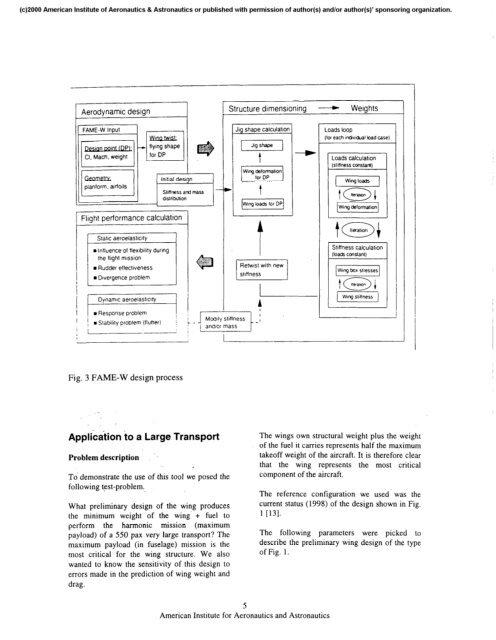





![Introduction to RF Stealth [Book Review] - Antennas and ...](https://img.yumpu.com/16857890/1/190x245/introduction-to-rf-stealth-book-review-antennas-and-.jpg?quality=85)

